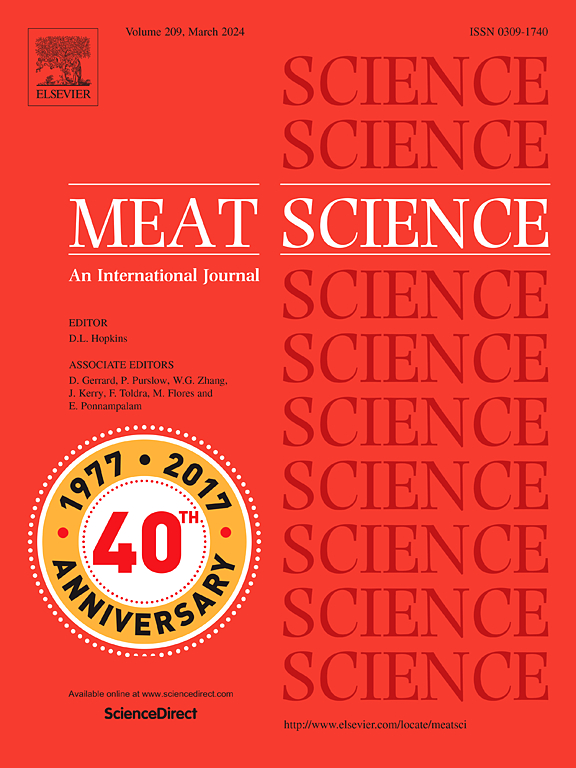不同脂肪酸谱的肉牛骨骼肌中差异表达的信使RNA亚型。
IF 7.1
1区 农林科学
Q1 Agricultural and Biological Sciences
引用次数: 0
摘要
本研究旨在根据内洛牛肌内脂肪酸谱,鉴定在肌肉组织中表达不同的mRNA亚型。采用48头公牛测定牛肉脂肪酸(FA)含量,并进行RNA测序分析。利用k-means分析方法对FA进行量化,并将其分为三组。Grp1聚集的动物PUFA、ω6、ω3、亚油酸、α-亚麻酸和PUFA/SFA比值显著升高,表明脂肪酸分布更有利。第3组动物表现出较高的棕榈酸、硬脂酸、肉豆蔻酸和SFA水平,这些都是不太有利的脂肪酸谱。Grp2包括介于Grp1和Grp3之间的脂肪酸水平中等的公牛。进行差异表达(DE)分析,通过Grp1与Grp2、Grp1与Grp3、Grp2与Grp3的对比来比较这三种不同的组。DE分析分别鉴定了Grp1与Grp2、Grp1与Grp3、Grp2与Grp3对比的总共62、26和30个转录本。在Grp1和Grp2组的比较中,我们发现了三个mRNA亚型,C7-203, ADD1-204和OXT-201,它们参与糖原和脂质代谢。这些mRNA亚型调节负责脂肪酸合成的关键基因,导致更高的PUFA含量。另一方面,在Grp1组和Grp3组的比较中,我们发现了RBM3-202和TRAG1-202 mRNA亚型,它们分别在肌肉发育、脂肪形成以及PUFA和MUFA浓度中起着至关重要的作用。Grp1 vs. Grp2和Grp2 vs. Grp3中发现的THRSP-201和FABP4-201的下调可能导致MUFA和SFA水平降低,而PUFA水平升高。此外,这些mRNA亚型与脂肪生成、脂肪酸运输和脂肪分解抑制有关。我们的研究结果表明,鉴定的mRNA亚型可以作为有希望的候选者,帮助制定策略来选择更高营养肉质的动物。本文章由计算机程序翻译,如有差异,请以英文原文为准。
Differentially expressed messenger RNA isoforms in beef cattle skeletal muscle with different fatty acid profiles
This study aimed to identify mRNA isoforms that were expressed differently in the muscle tissue of Nellore cattle based on their intramuscular fatty acid profile. Forty-eight young bulls were used to quantify beef fatty acids (FA) and perform RNA sequencing analysis. The young bulls were divided into three different groups based on quantifying FA using k-means analysis. The Grp1 clustered animals with significantly elevated levels of PUFA, ω6, ω3, linoleic acid, α-linolenic acid, and PUFA/SFA ratios, indicating a more favorable fatty acid profile. Animals in Group 3 demonstrated significantly higher levels of palmitic acid, stearic acid, myristic acid, and SFA, which are less favorable fatty acid profiles. Grp2 included bulls with intermediate levels of fatty acids, positioned between the profiles of Grp1 and Grp3. Differential expression (DE) analyses were performed to compare these three distinct groups through the contrasts: Grp1 vs. Grp2, Grp1 vs. Grp3, and Grp2 vs. Grp3. The DE analyses identified a total of 62, 26, and 30 transcripts for the contrasts Grp1 vs. Grp2, Grp1 vs. Grp3, and Grp2 vs. Grp3, respectively. In the comparison between the Grp1 and Grp2 groups, we identified three mRNA isoforms, C7–203, ADD1–204, and OXT-201, which are involved in glycogen and lipid metabolism. These mRNA isoforms regulate the key genes responsible for fatty acid synthesis, leading to a higher PUFA content profile. On the other hand, in the comparison between the Grp1 and Grp3 groups, the mRNA isoforms RBM3–202 and TRAG1–202 were identified and play a crucial role in muscle development, adipogenesis, and concentration of PUFA and MUFA, respectively. The downregulation of THRSP-201 and FABP4–201, isoforms identified in both, Grp1 vs. Grp2 and Grp2 vs. Grp3, contrasts may contribute to lower levels of MUFA and SFA and higher levels of PUFA. In addition, these mRNA isoforms were associated with lipogenesis, fatty acid transport, and inhibition of lipolysis. Our findings suggest that the identified mRNA isoforms could serve as promising candidates to help develop strategies to select animals of higher nutritional meat quality.
求助全文
通过发布文献求助,成功后即可免费获取论文全文。
去求助
来源期刊

Meat Science
工程技术-食品科技
CiteScore
12.60
自引率
9.90%
发文量
282
审稿时长
60 days
期刊介绍:
The aim of Meat Science is to serve as a suitable platform for the dissemination of interdisciplinary and international knowledge on all factors influencing the properties of meat. While the journal primarily focuses on the flesh of mammals, contributions related to poultry will be considered if they enhance the overall understanding of the relationship between muscle nature and meat quality post mortem. Additionally, papers on large birds (e.g., emus, ostriches) as well as wild-captured mammals and crocodiles will be welcomed.
 求助内容:
求助内容: 应助结果提醒方式:
应助结果提醒方式:


